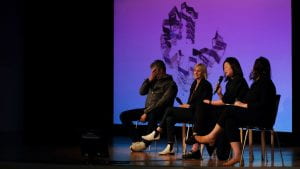On the special occasion of the Guggenheim’s 60th Anniversary, many of us had the opportunity to attend the Archtober Panel – Responding to Wright: Architects Design for the Guggenheim. On the panel were Lise Anne Couture, Hani Rashid and our Gale and Ira Drukier Dean, J. Meejin Yoon. We excited to hear their bold and site-specific exhibition design interventions that amplified the singularity of Wright’s architectural icon, the Guggenheim.

Designing for the Guggenheim is a complex challenge for most architects and curators since everything is at an angle. The geometry of the building must be taken into consideration when making curatorial decisions. Plus, it is challenging to ensure pieces stay in place and must be carefully corrected for any angle. AAP Dean Meejin Yoon’s 2004 project at the Guggenheim comprised of a singular linear surface that undulates around the spiral to create surplus surface area and display within its folds. The effect is a continuous and smooth non-uniform display system that organizes the different artifacts. The surface was generated using a simple algorithm that sorted the different artifacts. Some of the surprises of using felt as a material was that it absorbed sound and moisture culminating into an amazing learning experience that changed the museum experience. After the panel discussion, we had the opportunity to attend the 60th anniversary party and visit the current exhibition at the Guggenheim, Artistic License: Six Takes on the Guggenheim Collection, which brings together both well-known and rarely seen works from the turn of the century to 1980.

Even until today, Wright’s vision for the Guggenheim challenged, changed and continues to transform the relation relationship between art and architecture and the way architects design spaces for viewing art.
